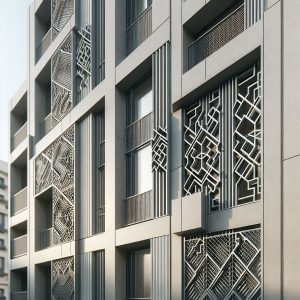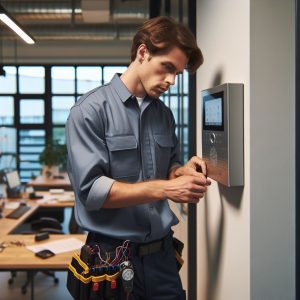Introduction
Closed-circuit television (CCTV) cameras are essential components of modern security systems, providing constant surveillance and alerts. With various types of CCTV cameras available, choosing the right one can be overwhelming. This article explores the different types of CCTV cameras, their features, pros and cons, and ideal use cases to help you make an informed decision.
1. Dome Cameras
Dome cameras are named for their dome-shaped housing, which makes it difficult to determine the direction the camera is facing. These cameras are often used for indoor surveillance due to their discreet design.
Pros:
- Discreet and unobtrusive design
- Vandal-resistant
- 360-degree coverage
Cons:
- Limited range of view
- PTZ (Pan-Tilt-Zoom) functionality could be limited
Ideal Use Case: Dome cameras are best suited for monitoring indoor spaces like offices, retail stores, and hotels, where a more inconspicuous surveillance solution is required.
2. Bullet Cameras
Bullet cameras are named for their bullet-shaped housing. They are weather-resistant and can be used for both indoor and outdoor surveillance. The elongated design allows for a longer lens, providing a more focused and distant view.
Pros:
- Weatherproof and durable
- Long-distance viewing
- Easy to install
Cons:
- Limited angle of motion for coverage
- Less discreet than dome cameras
Ideal Use Case: Bullet cameras are suitable for outdoor locations such as parking lots, driveways, and perimeters, where a focused and clear view is required to monitor specific areas.
3. PTZ Cameras (Pan-Tilt-Zoom)
PTZ cameras offer the ability to pan, tilt, and zoom, providing extensive coverage and flexibility. They can be controlled remotely, enabling users to focus on specific areas or track moving objects.
Pros:
- Wide coverage with remote access
- Zoom capability
- Good for changing surveillance coverage needs
Cons:
- Generally more expensive
- Require more maintenance
- Less discreet
Ideal Use Case: PTZ cameras are best suited for large areas that require active monitoring, such as stadiums, parking lots, and industrial facilities.
4. IP Cameras (Internet Protocol)
IP cameras are modern CCTV cameras that transmit data over the internet or a network. They offer high-resolution images and can be accessed remotely through smartphones or computers.
Pros:
- High resolution and latest features
- Remote access and monitoring
- Scalable and flexible
Cons:
- Require a strong internet connection
- Can be more expensive than analog cameras
Ideal Use Case: IP cameras are ideal for both residential and commercial properties where high-quality images and remote access are essential.
5. Wireless Cameras
Wireless cameras transmit video and audio signals to a wireless receiver, eliminating the need for cables. They are easy to install and can be placed in various locations.
Pros:
- Easy installation
- Flexible placement
- No need for cables
Cons:
- Signal interference can occur
- Limited range compared to wired cameras
Ideal Use Case: Wireless cameras are perfect for homes and small businesses where ease of installation and flexibility are important.
6. Thermal Cameras
Thermal cameras detect heat signatures and are used in environments where traditional cameras might fail, such as in complete darkness or through smoke and fog.
Pros:
- Can see in complete darkness
- Detects heat signatures
- Effective in adverse weather conditions
Cons:
- Generally more expensive
- Lower resolution compared to standard cameras
Ideal Use Case: Thermal cameras are ideal for critical infrastructure, border security, and areas with low visibility.
7. Discreet Cameras
Discreet cameras are designed to blend into their surroundings, making them less noticeable. They can be hidden in everyday objects like clocks, smoke detectors, or speakers.
Pros:
- Highly discreet
- Can be hidden in plain sight
- Effective for covert surveillance
Cons:
- Limited features compared to standard cameras
- May have lower resolution
Ideal Use Case: Discreet cameras are suitable for environments where covert surveillance is necessary, such as in retail stores to monitor for theft.
8. Day/Night Cameras
Day/Night cameras are designed to function in both well-lit and low-light conditions. They switch between color imaging during the day and black-and-white imaging at night.
Pros:
- Effective in varying lighting conditions
- Can switch between color and black-and-white modes
- Suitable for 24/7 surveillance
Cons:
- May require additional lighting for optimal performance
- Can be more expensive than standard cameras
Ideal Use Case: Day/Night cameras are perfect for outdoor surveillance where lighting conditions change throughout the day.
9. 360 Degree Cameras
360-degree cameras provide a panoramic view, covering a wide area with a single camera. They are often used in large open spaces.
Pros:
- Wide coverage area
- Reduces the need for multiple cameras
- Can provide immersive views
Cons:
- Can be more expensive
- May have lower resolution at the edges of the image
Ideal Use Case: 360-degree cameras are ideal for large open areas such as shopping malls, airports, and public squares.
10. ANPR/LPR Cameras (Automatic Number Plate Recognition/License Plate Recognition)
ANPR/LPR cameras are specialized cameras designed to capture and recognize vehicle license plates. They are used for traffic management and security purposes.
Pros:
- Accurate license plate recognition
- Useful for traffic management
- Can integrate with other security systems
Cons:
- Specialized and can be expensive
- Requires proper positioning for accuracy
Ideal Use Case: ANPR/LPR cameras are suitable for parking lots, toll booths, and areas requiring vehicle access control.
11. Infrared (IR) Cameras
Infrared cameras use infrared technology to capture images in low-light or no-light conditions. They are equipped with IR LEDs that illuminate the area being monitored.
Pros:
- Effective in complete darkness
- Provides clear images in low-light conditions
- Suitable for 24/7 surveillance
Cons:
- IR illumination can be visible to the naked eye
- Limited range compared to thermal cameras
Ideal Use Case: Infrared cameras are ideal for nighttime surveillance in areas such as warehouses, parking lots, and residential properties.
Conclusion
Choosing the right CCTV camera depends on your specific surveillance needs and the environment in which the camera will be used. By understanding the different types of CCTV cameras and their features, you can make an informed decision to enhance the security of your property.
Secure Your Home and Business with Garrison Alarms!
Experience unmatched safety with Garrison Alarms – your trusted partner in cutting-edge home and business security solutions. With over 35 years of experience, we offer expert installation, state-of-the-art technology, and personalized security strategies tailored to your unique needs.
Our Services Include:
- Home & Business Alarms: Maximize security with our advanced wired and wireless alarm systems.
- CCTV Systems: Protect your property with high-resolution, 4K HD, and color night vision cameras.
- Access Control: Secure your premises with keypad entry, biometric solutions, and more.
- Alarm Monitoring: 24/7 monitoring to ensure your safety and peace of mind.
Why Choose Garrison Alarms?
- Expert & Professional Service: Our licensed technicians provide top-notch installation and support.
- Customer Satisfaction: We prioritize your security and satisfaction with a focus on quality and reliability.
- Affordable Pricing: Get the best security solutions at competitive prices.
Get a FREE Quote Today! Visit Garrison Alarms or call us at 09 520 4875 to learn more and secure your property today!
Garrison Alarms – Your Safety, Our Priority





